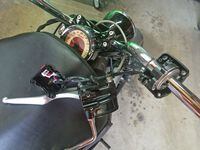WRIST: Brian Hatano
MSRP (2015): $11,299
MILES: 5,920
MPG: 40
MODS: Trask V-Line Handlebar
Have you ever tried to bend your own set of handlebars? It’s not as easy as it seems, or perhaps I’m just not as good with making multiple symmetrical left-and-right bends and contours in tubing as I am with shaping sheetmetal. Even using the best Mittler Bros. electric-hydraulic bender and calculating the project with Bend Tech software, I sent three 10-foot sticks of steel tubing into the dumpster (that’s three tries) before I succeeded in making my first set of apehangers for a custom build I was working on. The only thing simpler than apes would be to put four even 90-degree bends on a flat plane (no contour or pull-back) and call it a day.
My skills improved over time thanks to more mistakes and practice, but the lesson here is that there is nothing like discovering how difficult a fabrication task is before you can truly appreciate a good quality aftermarket product.
Welding bars together is less complicated; however, other factors such as welding skill and equipment come into play. And the finished product will have angles and gussets rather than smooth bends. Not a bad thing. It’s just a matter of preference.
As comfortable as they are, I desperately wanted to get away from the pull-back style of the OEM bars. Making my own set of bars for the Scout would require both bending and welding since the one-inch-diameter Scout bars reduce to ⅞-inch at the hand controls. I considered it for a split-second but the moment quickly passed when I saw a handlebar made by Trask Performance, the company that makes the 2-1 exhaust pipe that is currently on my long-term bike.
The Trask V-Line Handlebar for the Indian Scout ($309.95 in chrome or black; $279.95 for raw finish) is made from one-inch-OD seamless DOM (drawn over mandrel) steel tubing with ends that reduce to ⅞-inch just like the stock bars. According to the Trask website (traskperformance.com), the V-Line is a "direct bolt-on replacement" designed to use the OEM controls.
The change-out process is the same as if you were swapping the stock bar for one of Indian’s extended- or reduced-reach options. As with any modification, a service manual is a valuable tool to help you through the process. If you can’t find a manual it’s a doable mod for all but the most hamfisted DIYer; easier than a comparable swap on a Harley-Davidson thanks to a thoughtful ride-by-wire throttle assembly. No cables to loosen and readjust. As long as you map the removal of each control (remember how you took it apart), you’ll have no problem reversing the process. Tools needed: a fitted tank cover is optional but so much better than a blanket for protecting the finish. I used my Snap-on cover designed for Harley fat bob tanks and the fit on the Scout tank was almost perfect. Compressed air is nice to have for removing and reinstalling the left grip (the right-side grip slides off and on with the throttle tube). I also suggest a set of good T-handle Torx wrenches and ¼-inch or ⅜-inch drive Allen sockets with ratchet and short extension.
I’m extremely pleased with all aspects of the Trask handlebar installation. Not only do they add a more aggressive look that I’m after, but they’re also just as comfortable (to me) as the excellent ergos of the stock Scout setup. Combined with the reduced-reach seat’s extra rear support that pushes me up towards the tank, the Trask bars put me in a more sporting position with a slight forward lean, just enough to bring the controls closer. I’ll be keeping these bars on the Scout until it’s time to go back to Indian.
If you’re a new Scout owner with plans to perform your first handlebar swap, don’t be intimidated by the unknown. The Trask V-Line Handlebar is a perfect fit with no hidden surprises waiting for you during this installation. Just take your time, use the right tools and allow yourself a few hours to complete the job.


















/cloudfront-us-east-1.images.arcpublishing.com/octane/2WF3SCE3NFBQXLDNJM7KMXA45E.jpg)
/cloudfront-us-east-1.images.arcpublishing.com/octane/G4MG6OUCJNBSHIS2MVVOTPX65E.jpg)
/cloudfront-us-east-1.images.arcpublishing.com/octane/IIGGWFOTOJGB7DB6DGBXCCMTDY.jpg)
/cloudfront-us-east-1.images.arcpublishing.com/octane/QSTCM6AVEZA5JJBUXNIQ3DSOF4.jpg)
/cloudfront-us-east-1.images.arcpublishing.com/octane/U4I7G625B5DMLF2DVIJDFZVV6M.jpg)
/cloudfront-us-east-1.images.arcpublishing.com/octane/B6XD6LS6IVCQPIU6HXDJSM3FHY.jpg)
/cloudfront-us-east-1.images.arcpublishing.com/octane/ICL63FEDDRDTTMINYICCEYGMDA.jpg)
/cloudfront-us-east-1.images.arcpublishing.com/octane/FCGZHQXRBZFLBAPC5SDIQLVF4I.jpg)
/cloudfront-us-east-1.images.arcpublishing.com/octane/WNOB6LDOIFFHJKPSVIWDYUGOPM.jpg)

/cloudfront-us-east-1.images.arcpublishing.com/octane/X33NU3E525ECRHXLNUJN2FTRKI.jpg)
/cloudfront-us-east-1.images.arcpublishing.com/octane/6KKT5NNL2JAVBOXMZYS5ZO76YA.jpg)
/cloudfront-us-east-1.images.arcpublishing.com/octane/J5RKG5O455GMPGQRF2OG6LRT7A.jpg)
/cloudfront-us-east-1.images.arcpublishing.com/octane/GX2CIZKQVRH2TATDM26KFG2DAE.jpg)
/cloudfront-us-east-1.images.arcpublishing.com/octane/ZWIDYSAKQZHD5BHREMQILXJCGM.jpg)
/cloudfront-us-east-1.images.arcpublishing.com/octane/CYUHJZCTSJCH3MRAQEIKXK7SCQ.jpg)
/cloudfront-us-east-1.images.arcpublishing.com/octane/LKOFINY56FCXJCANJ5M7ZDQUBY.jpg)
/cloudfront-us-east-1.images.arcpublishing.com/octane/4NBPDACMWJH63JQYJVK3QRBDZI.jpg)
/cloudfront-us-east-1.images.arcpublishing.com/octane/KKHQHRR3FJGX7H2IPU6RALMWG4.jpg)

/cloudfront-us-east-1.images.arcpublishing.com/octane/5IOFS5JAE5FOXMNA23ZRAVVYUU.jpg)
/cloudfront-us-east-1.images.arcpublishing.com/octane/CGXQ3O2VVJF7PGTYR3QICTLDLM.jpg)

/cloudfront-us-east-1.images.arcpublishing.com/octane/OQVCJOABCFC5NBEF2KIGRCV3XA.jpg)